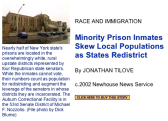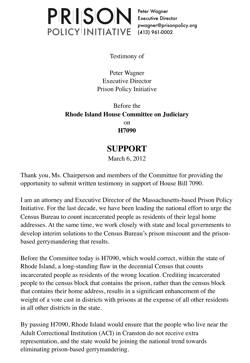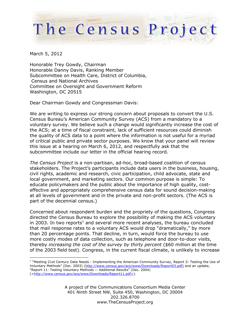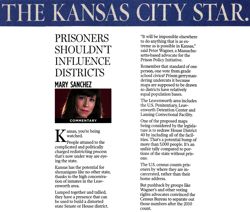First national article to explain prison-based gerrymandering is still timely.
by Peter Wagner,
March 12, 2012

The first major national article about prison-based gerrymandering appeared ten years ago today. Jonathan Tilove, then the race and immigration reporter for Newhouse News Service, wrote a major feature that connected the dots between my academic research on how the Census Bureau’s prison counts distort democracy in the New York State legislature, Taren Stinebrickner-Kauffman’s research on prison demographics in Florida, and the redistricting struggles of county officials in Colorado, Louisiana and Florida.
To quote from Jonathan’s article, at the time the “issue [hadn’t] gained much serious attention or debate at the national or state levels.” But the article changed all that.
As I wrote on the 10th anniversary of the founding of the Prison Policy Initiative:
Prior to Jonathan’s article, explaining my research used to take hours. His piece helped us succinctly explain who benefits from prison-based gerrymandering. For example, in a single clear sentence Jonathan powerfully summarized one concept that used to take me 15 minutes to explain. Many of the innovations in Jonathan’s article informed how we constructed our “Importing Constituents” report, and Jonathan’s discussion of intra-rural impacts inspired our strategy for the next decade.
The article’s publication introduced our work to Brenda Wright, then managing attorney at the National Voting Rights Institute, and now Director of the Democracy Program at Demos. Brenda reached out to share her expertise and has been one of our closest advisors and colleagues ever since.
The movement to abolish prison-based gerrymandering has come along way since Jonathan’s article was written, with advances such as:
- The publication of dozens of reports on how prison-based gerrymandering distorts democracy in state and local governments across the country
- The New York Times editorial board coining the term “prison-based gerrymandering”
- Four states passing legislation to end prison-based gerrymandering
- The Census Bureau changing how prison count data is published
- Hundreds of counties and municipalities refusing to engage in prison-based gerrymandering
There’s been great progress since 2002, but the article is still a concise introduction to the problem, and a powerful explanation of how the Census Bureau’s prison miscount is bad for both urban and rural people. In Iberville Parish Louisiana, prison-based gerrymandering would have meant drawing a school board district that had only two voters. In the New York Senate, legislators who supported prison expansion boasted that they were glad that people incarcerated in their districts couldn’t vote because “they wouldn’t vote for me”.
Ten years ago, prison-based gerrymandering was virtually unknown. The issue was intriguing but complicated and obscure. Jonathan Tilove’s article was the first to focus on this problem and to give the public the tools they need to understand why prison-based gerrymandering needed to be abolished.
If you missed his article ten years ago, or if you haven’t read it again recently, today is a great time to read it again.
Several civil rights organizations submitted testimony to the House Committee on Judiciary in support of House Bill 7090, which would end prison-based gerrymandering in the state.
by Leah Sakala,
March 7, 2012

Yesterday several civil rights groups testified before the Rhode Island House Committee on Judiciary in support of House Bill 7090, which would end prison-based gerrymandering in the state.
The legislation would fix the harm caused by the Census Bureau’s prison miscount by requiring that incarcerated people be reallocated to their home addresses in state legislative redistricting data beginning in 2020. The bill would also bring Rhode Island’s redistricting practices in compliance with state law, which explicitly states that a prison is not a residence. By passing HB 7090, Rhode Island would join the growing national trend towards rejecting prison-based gerrymandering.
Organizations that testified in support of HB 7090 included the ACLU of Rhode Island, Common Cause Rhode Island, the Prison Policy Initiative, the Urban League, and Direct Action for Rights and Equality. The written testimonies submitted by the Prison Policy Initiative (testimony) and Common Cause Rhode Island (testimony) are available online.
As advocates pointed out, prison-based gerrymandering is especially problematic in Rhode Island because the state has a single prison complex that’s concentrated in one geographic location. This makes it particularly difficult to diminish the harm of prison-based gerrymandering by splitting the prisons into multiple pieces when drawing legislative redistricting maps.
In the current redistricting cycle, for example, the redistricting commission struggled with how to mitigate the harm of prison-based gerrymandering, and the final maps include a district that is 15% incarcerated. This means that 85 people in that district have as much political clout as 100 people who live in a district without a prison.
There was no opposition to the bill at last night’s hearing. It’s time for Rhode Island to take a stand and pass HB 7090 to ensure that prison-based gerrymandering does not compromise Rhode Island residents’ right to vote after the 2020 Census.
PPI signed on to a Census Project coalition letter in opposition to a recent proposal to make participation in the ACS voluntary rather than mandatory.
by Leah Sakala,
March 6, 2012

The Prison Policy Initiative joined more than 25 other Census Project organizations to send a letter to House congressional leaders in opposition to a recent proposal to make participation in the American Community Survey voluntary rather than mandatory.
The American Community Survey provides vital information to public and private sector decision-makers alike, and the coalition letter warns that making participation in the survey voluntary would dramatically compromise the data by decreasing the response rate and increasing the expense.
The Prison Policy Initiative typically focuses on how the Census Bureau’s method of counting people in prison in the decennial Census negatively affects the redistricting process. The expertise we developed for that project has led to a deeper appreciation for the importance of other Census Bureau data products. We’ve learned just how important the American Community Survey is, so we joined the Census Project in this important letter.
The letter concludes:
[W]e urge your subcommittee to view any proposal to make the American Community Survey voluntary with great caution. Such a change would have serious adverse consequences that could leave the nation in a precarious decision-making vacuum and hinder its economic recovery and future growth.
A new Kansas City Star piece by Mary Sanchez warns that prison-based gerrymandering may dramatically inflate the votes cast in a Kansas state legislative district.
by Leah Sakala,
March 5, 2012

Mary Sanchez has just released a great piece in the Kansas City Star about how prison populations are a big deal in Kansas state legislative redistricting.
She explains that the high concentration of correctional facilities in a single legislative district may cause the most dramatic instance of artificial vote inflation in any state district in the nation:
Kansas has the potential for shenanigans like no other state, thanks to the high concentration of inmates in the Leavenworth area.
Lumped together and tallied, they have a presence that can be used to build a distorted state Senate or House district. Prisoner counts can dilute voting power in some areas while falsely ramping it up for voters living near prisons.
She points out that not only does Kansas have the ability to refuse to engage in prison-based gerrymandering, its current practice of reallocating military and school populations for redistricting purposes has served as a national model for redistricting population adjustments:
Remember that standard of one person, one vote from grade school civics? Prison gerrymandering undercuts it because maps are supposed to be drawn so districts have relatively equal population bases.
The Leavenworth area includes the U.S. Penitentiary, Leavenworth Detention Center and Lansing Correctional Facility.
One of the proposed maps being considered by the legislature is to redraw House District 40 by including all of the facilities. That’s a potential bump of more than 5,000 people. It’s an unfair tally compared to portions of the state without prisons.
The U.S. census counts prisoners by where they are incarcerated, rather than their home address. But pushback by groups like Wagner’s and other voting rights advocates convinced the Census Bureau to separate out those numbers after the 2010 count.
Meaning if Kansas wanted to play this game fairly, it could.
In fact, Kansas is considered a model for addressing the temporary residency of college students and military personnel.
The Kansas legislature needs take swift action to remove prison populations from the population data used for redistricting purposes. Otherwise the state will dilute the votes of every resident who doesn’t live next to a prison, and become a dramatic national symbol of how prison-based gerrymandering dilutes your right to vote.
One Wyoming district is moved 17 miles to include a prison; padding one district with a large prison protects two incumbents from facing each other.
by Peter Wagner,
March 4, 2012
Joan Barron writes in today’s Casper Star-Tribune about the most blatant case of prison-based gerrymandering I have ever seen: a Wyoming Senate district that snakes around an incumbents house and then follows the Nebraska border for 17 miles to snag a prison. The initial proposed districts had the two incumbents facing each for re-election, but using the prison to pad one district shifted the other incumbent into a separate district.

Graphic by Bob Machuga
I typically write about the problem of prison-based gerrymandering in terms of vote dilution. The shape of the prison district is problematic, but is separate from that issue.
In our analysis, we found several new Wyoming legislative districts that meet federal minimum population requirements only by using prison populations as padding. The prison population can’t vote, and by state law they retain their pre-incarceration residences. Counting incarcerated people in the wrong location gives extra political influence to the districts with prisons, and dilutes the votes of residents who live in any other district.
The truly unique part about prison-based gerrymandering in Wyoming is how blatant it is. In order to increase his chances for re-election, Senator Meier insisted that his house be shifted to another district. The captive population at the Wyoming Medium Correctional Institution made the perfect inert ballast to shore up the district his house previously was in.
Besides prison finger’s funny shape, the legislature’s other major redistricting controversy was about which counties were split. Keeping communities together makes a lot of sense, and that principle applies to prison populations too. That’s why four states have passed laws to count incarcerated people at home for redistricting purposes. It doesn’t make sense to use prison populations to pad out any one district when their real residences are in other parts of the state.
Most state and local governments are moving towards ending prison-based gerrymandering. Wyoming’s new maps buck that trend and deliberately go the other way. Wyoming will get some ridicule for the funny finger shaped district; but the real losers are every resident of the state who does not live next to a large prison.








